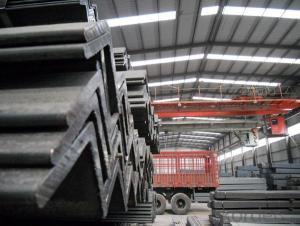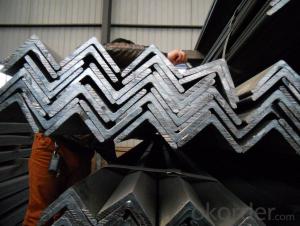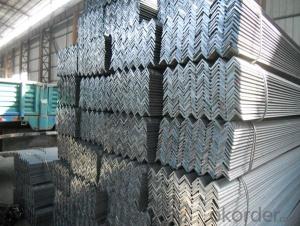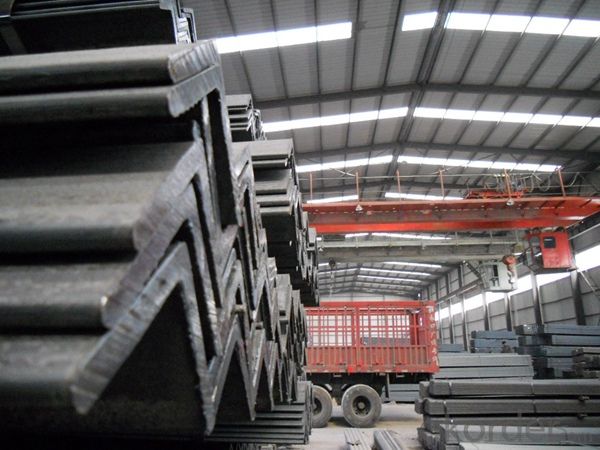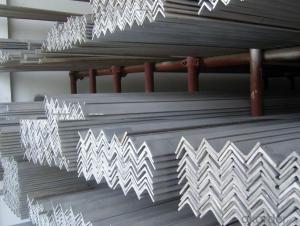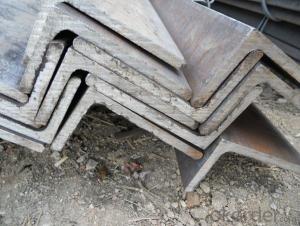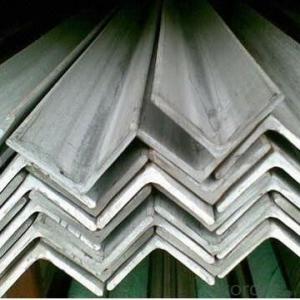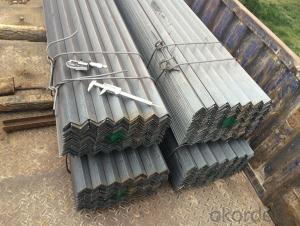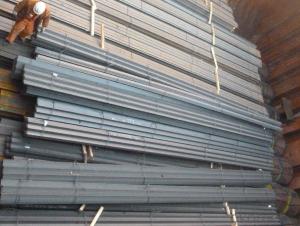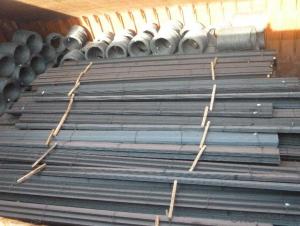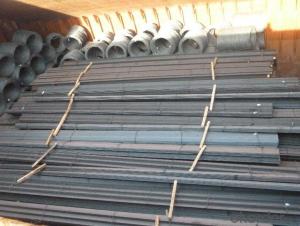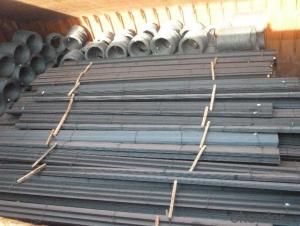Hot Rolled EN Standard Equal Angle Steel Bars for Construction, Structure
- Loading Port:
- Tianjin
- Payment Terms:
- TT OR LC
- Min Order Qty:
- 25 m.t.
- Supply Capability:
- 200000 m.t./month
OKorder Service Pledge
OKorder Financial Service
You Might Also Like
Product Description:
OKorder is offering Hot Rolled EN Standard Equal Angle Steel Bars for Construction, Structure at great prices with worldwide shipping. Our supplier is a world-class manufacturer of steel, with our products utilized the world over. OKorder annually supplies products to European, North American and Asian markets. We provide quotations within 24 hours of receiving an inquiry and guarantee competitive prices.
Product Applications:
Hot Rolled EN Standard Equal Angle Steel Bars for Construction, Structure are ideal for structural applications and are widely used in the construction of buildings and bridges, and the manufacturing, petrochemical, and transportation industries.
1. Supporting members, most commonly in the house raising industry to strengthen timber bears under houses. Transmission line towers, etc
2. Prefabricated structure
3. Medium scale bridges
4. It is widely used in various building structures and engineering structures such as roof beams, bridges, transmission towers, hoisting machinery and transport machinery, ships, industrial furnaces, reaction tower, container frame and warehouse etc.
Product Advantages:
Hot Rolled EN Standard Equal Angle Steel Bars for Construction, Structure are durable, strong, and resist corrosion.
Main Product Features:
· Premium quality
· Prompt delivery & seaworthy packing (30 days after receiving deposit)
· Corrosion resistance
· Can be recycled and reused
· Mill test certification
· Professional Service
· Competitive pricing
Product Specifications:
1.Standards:GB,ASTM,BS,AISI,DIN,JIS
2.Length:6m,9m,12m
3.Material:GBQ235B,Q345BorEquivalent;ASTMA36;EN10025,S235JR,S355JR;JISG3192,SS400;SS540.
4. Sizes

Sizes: 25mm-250mm | ||
a*t | ||
25*2.5-4.0 | 70*6.0-9.0 | 130*9.0-15 |
30*2.5-6.6 | 75*6.0-9.0 | 140*10-14 |
36*3.0-5.0 | 80*5.0-10 | 150*10-20 |
38*2.3-6.0 | 90*7.0-10 | 160*10-16 |
40*3.0-5.0 | 100*6.0-12 | 175*12-15 |
45*4.0-6.0 | 110*8.0-10 | 180*12-18 |
50*4.0-6.0 | 120*6.0-15 | 200*14-25 |
60*4.0-8.0 | 125*8.0-14 | 250*25 |
5. Payment terms:
1).100% irrevocable L/C at sight.
2).30% T/T prepaid and the balance against the copy of B/L.
3).30% T/T prepaid and the balance against L/C
6.Material details:
Alloy No | Grade | Element (%) | |||||
C | Mn | S | P | Si | |||
Q235 | B | 0.12—0.20 | 0.3—0.7 | ≤0.045 | ≤0.045 | ≤0.3 | |
Alloy No | Grade | Yielding strength point( Mpa) | |||||
Thickness (mm) | |||||||
≤16 | >16--40 | >40--60 | >60--100 | ||||
≥ | |||||||
Q235 | B | 235 | 225 | 215 | 205 | ||
Alloy No | Grade | Tensile strength (Mpa) | Elongation after fracture (%) | ||||
Thickness (mm) | |||||||
≤16 | >16--40 | >40--60 | >60--100 | ||||
≥ | |||||||
Q235 | B | 375--500 | 26 | 25 | 24 | 23 | |
FAQ:
Q1: Why buy Materials & Equipment from OKorder.com?
A1: All products offered byOKorder.com are carefully selected from China's most reliable manufacturing enterprises. Through its ISO certifications, OKorder.com adheres to the highest standards and a commitment to supply chain safety and customer satisfaction.
Q2: How do we guarantee the quality of our products?
A2: We have established an advanced quality management system which conducts strict quality tests at every step, from raw materials to the final product. At the same time, we provide extensive follow-up service assurances as required.
Q3: How soon can we receive the product after purchase?
A3: Within three days of placing an order, we will begin production. The specific shipping date is dependent upon international and government factors, but is typically 7 to 10 workdays.
Q4: What makes stainless steel stainless?
A4: Stainless steel must contain at least 10.5 % chromium. It is this element that reacts with the oxygen in the air to form a complex chrome-oxide surface layer that is invisible but strong enough to prevent further oxygen from "staining" (rusting) the surface. Higher levels of chromium and the addition of other alloying elements such as nickel and molybdenum enhance this surface layer and improve the corrosion resistance of the stainless material.
Q5: Can stainless steel rust?
A5: Stainless does not "rust" as you think of regular steel rusting with a red oxide on the surface that flakes off. If you see red rust it is probably due to some iron particles that have contaminated the surface of the stainless steel and it is these iron particles that are rusting. Look at the source of the rusting and see if you can remove it from the surface.
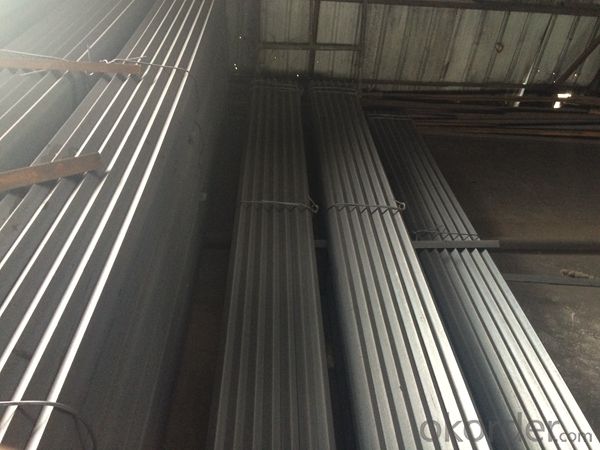

- Q: Are there any limitations or restrictions on the use of steel angles?
- Indeed, there exist certain limitations and restrictions pertaining to the utilization of steel angles. One of these limitations concerns the maximum load capacity that they can withstand. The load-bearing capacity of steel angles depends on their size, shape, and material composition. Exceeding this capacity can result in structural failure or collapse. Another limitation is associated with the installation and fixing methods of the angles. Typically, steel angles are secured through welding, bolting, or other fastening techniques. The effectiveness and strength of these methods can be influenced by factors like weld quality or the type of fasteners employed. To ensure secure attachment, it is imperative to adhere to proper installation procedures and recommended guidelines. Furthermore, steel angles may face restrictions on their usage in specific environments or applications. For instance, in highly corrosive environments, steel angles may not be suitable unless appropriate protective coatings or materials are utilized. Similarly, in applications where fire resistance is crucial, steel angles may need to be treated with fire-resistant coatings or replaced with fire-resistant materials. Moreover, limitations can arise from the dimensions and lengths of steel angles. Steel angles are available in various sizes and lengths, and careful selection of these dimensions is essential to meet the specific requirements of a project. Factors such as load distribution, span length, and overall structural design must be considered to ensure the suitability of the chosen steel angles for the intended application. To summarize, while steel angles are versatile and widely employed in construction and engineering applications, it is crucial to be aware of their limitations and restrictions. These include load-bearing capacity, installation methods, environmental considerations, and dimensional constraints. Consulting with structural engineers, adhering to industry standards, and implementing proper planning are essential to ensure the safe and effective use of steel angles.
- Q: What is the angle iron back machine?
- The process of removing the right angle of the angle steel is to shovel back, also called shovel edge. The traditional machining and low production efficiency, high labor intensity, the company through a large number of technological innovation, design and manufacture of efficient continuous feeding (limited length) of the TGC200 series CNC shoveling machine, can fully meet the demand of processing in shoveling tower.
- Q: Can steel angles be used in seismic or high-wind areas?
- Yes, steel angles can be used in seismic or high-wind areas. Steel angles are commonly used in construction for their strength and durability. They are able to withstand the forces exerted during seismic events or strong winds, making them a suitable choice for such areas. Additionally, steel angles can be designed and reinforced to meet specific requirements for these challenging conditions.
- Q: Angle iron specifications 125 * 80 * 101 m multiple
- Angle steel is a kind of carbon structural steel for construction. It is a simple section steel, mainly used in the frame of metal component and workshop. In use, better weldability, plastic deformation and mechanical strength are required. The raw steel billet for producing angle steel is low carbon square billet, and the finished product angle iron is made by hot rolling, normalizing or hot rolling.
- Q: How do steel angles perform in extreme weather conditions?
- Steel angles are designed to be highly durable and resistant to extreme weather conditions. They are commonly used in construction and structural applications due to their strength and ability to withstand harsh environments. In extreme weather conditions such as hurricanes, heavy snowfall, or high winds, steel angles provide excellent protection against these elements. One of the key factors that contribute to the performance of steel angles in extreme weather conditions is their high tensile strength. Steel angles can withstand substantial loads and forces without deforming or breaking, making them ideal for withstanding extreme weather events. Additionally, steel angles are known for their excellent resistance to corrosion, which is crucial in areas with high humidity, saltwater, or acidic environments. Steel angles are also highly versatile, allowing them to be easily fabricated and customized to meet specific project requirements. This flexibility ensures that they can be used in a wide range of applications, including buildings, bridges, towers, and other structures that are exposed to extreme weather conditions. Moreover, steel angles can be coated or treated to further enhance their weather resistance. For example, a galvanized coating can provide added protection against rust and corrosion, extending the lifespan of the steel angles even in the harshest weather conditions. In summary, steel angles are designed to perform exceptionally well in extreme weather conditions. Their high tensile strength, corrosion resistance, and versatility make them a reliable choice for structures that need to withstand hurricanes, heavy snowfall, high winds, and other challenging weather events.
- Q: How do you calculate the moment resistance of a steel angle?
- In order to determine the moment resistance of a steel angle, one must take into account the angle's geometry and material properties. The moment resistance refers to the angle's capacity to withstand bending forces. Initially, the section modulus must be calculated, which measures the shape's resistance to bending. The section modulus is obtained by dividing the angle's moment of inertia (I) by the distance from the shape's centroid to the farthest point (c). Subsequently, the yield strength of the steel angle needs to be determined. This is the point at which the material begins to permanently deform. The yield strength is typically provided by the manufacturer or can be acquired through material testing. Lastly, the moment resistance can be calculated by multiplying the section modulus (Z) by the yield strength (σ). This calculation yields the maximum moment that the steel angle can withstand before permanent deformation occurs. Moment Resistance = Z * σ It is important to note that this calculation assumes that the steel angle is solely subjected to bending. If there are additional factors present, such as axial or shear forces, further calculations or considerations may be necessary. Furthermore, it is always advisable to consult relevant design codes or engineering handbooks for more precise and detailed calculations.
- Q: Can steel angles be used to create decorative elements in architecture?
- Definitely, decorative architectural elements can indeed be created using steel angles. These versatile angle irons can be easily manipulated to form a variety of shapes and designs. Cutting, bending, and welding them allows for the creation of intricate patterns, ornamental details, and decorative accents. Steel angles find application in various architectural features like railings, balusters, window grilles, door frames, brackets, and ornamental trims. Their strength and durability make them suitable for both indoor and outdoor use. Adding different coatings, such as paint or powder coating, can enhance their appearance and protect them from corrosion. Architects and designers often incorporate steel angles into modern and contemporary designs to impart an industrial, sleek, and minimalist touch. The clean lines and geometric shapes of steel angles bring a modern aesthetic to buildings and structures. Utilizing them to create unique and captivating patterns adds visual interest and a sense of style to architectural projects. Additionally, steel angles can be combined with other materials like glass, wood, or stone, to achieve a striking contrast and a harmonious blend of materials. This versatility offers infinite design possibilities, enabling architects to create truly personalized and distinctive decorative elements. In conclusion, steel angles can be effectively utilized to create decorative elements in architecture. Their versatility, strength, and potential for customization make them an ideal choice for architects and designers seeking to enhance the aesthetic appeal and uniqueness of their projects.
- Q: What are the load-bearing capacities of steel angles?
- The load-bearing capacities of steel angles may differ due to various factors, such as the angle's size, thickness, and the type of steel used, as well as its specific application. Typically, steel angles are designed to offer structural support and can handle substantial loads. The load-bearing capacity of a steel angle is determined by its ability to withstand compression and tension forces, as well as its bending strength. These factors are influenced by the material properties of the steel, including its yield strength, tensile strength, and ductility. Steel angles find common usage in construction and engineering projects, where they are employed to support beams, frames, and structures. Engineers or designers usually specify the load-bearing capacity of a steel angle based on the project's specific requirements and the expected loads. Calculations and structural analysis, following engineering principles and standards, are typically carried out to determine the load-bearing capacity of a steel angle. These calculations take into account the angle's dimensions, support conditions, and the anticipated loads. To ensure that a steel angle's load-bearing capacity meets the necessary requirements for a given application, it is crucial to consult relevant engineering codes and standards provided by organizations such as the American Institute of Steel Construction (AISC) or British Standards Institution (BSI). In conclusion, the load-bearing capacities of steel angles can differ based on several factors. To accurately determine the load-bearing capacity of a specific steel angle for a given application, it is important to consult with a structural engineer or refer to appropriate engineering standards.
- Q: How do you calculate the slenderness ratio of a steel angle?
- In order to find the slenderness ratio of a steel angle, one must ascertain the length and moment of inertia of the angle section. This ratio serves as a measure of the member's slenderness and aids in determining its stability and resistance to buckling. To begin, measure the length of the steel angle, which is the distance between its two ends. It is essential to use the same unit of measurement as the dimensions of the angle section. Next, compute the moment of inertia of the steel angle section. The moment of inertia, denoted as "I," quantifies the section's ability to resist bending. It relies on the dimensions of the angle section and can be obtained from reference tables or calculated through mathematical formulas. After obtaining the length and moment of inertia of the steel angle, the slenderness ratio can be calculated using the following formula: Slenderness ratio = Length of angle / √(Moment of inertia) Ensure that both the length and moment of inertia are expressed in the same unit before performing the calculation. The resulting slenderness ratio will be a dimensionless value. It is important to note that the slenderness ratio is utilized to establish appropriate design criteria and allowable loads for the steel angle. Different design codes or standards may impose specific limits or guidelines regarding the maximum slenderness ratio deemed safe for various applications. Therefore, it is crucial to consult relevant design codes or seek professional engineering advice to ensure the correct and safe utilization of the steel angle.
- Q: Are steel angles suitable for earthquake-prone areas?
- Yes, steel angles are suitable for earthquake-prone areas. Steel is a strong and durable material that can withstand seismic forces and provide structural stability during earthquakes. The use of steel angles helps distribute the load and reinforce the structure, making it more resistant to seismic activity.
Send your message to us
Hot Rolled EN Standard Equal Angle Steel Bars for Construction, Structure
- Loading Port:
- Tianjin
- Payment Terms:
- TT OR LC
- Min Order Qty:
- 25 m.t.
- Supply Capability:
- 200000 m.t./month
OKorder Service Pledge
OKorder Financial Service
Similar products
Hot products
Hot Searches
Related keywords
